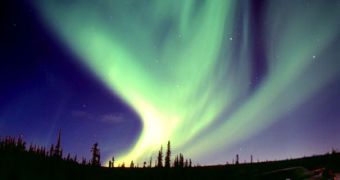Known as aurora borealis in northern latitudes (after the Roman goddess of dawn, Aurora, and the Greek name for north wind) and as aurora australis in the South (australis meaning "of the South"), the beautiful lights in the sky are now known to be caused by the collision of charged particles (electrons), found in the magnetosphere, with atoms in the Earth's upper atmosphere (at altitudes above 80 km).
If you've ever been lucky enough to see the Aurora Borealis or the Aurora Australis, you know it's a truly impressive sight. Seeing the lights dancing against the sky is a memorable experience, than can be lived only in a ring-shaped region of about 1560 miles (2500 km) around the magnetic poles of the Earth, not its geographic one.
Early in the evening, the aurora often forms a motionless green arc that stretches across the sky in the east-west direction.
Colorful dancing auroral forms are the results of disturbances known as "substorms" or "tsunamis" taking place in Earth's magnetosphere.
Unfortunately, their beauty can also affect us in a negative way, because auroras are known to disturb satellites, electrical grids, and even interrupt GPS signals.
Magnetospheric tsunamis or substorms typically last one to two hours and are three-dimensional physical phenomena spread over altitudes from 100 to 150 000 kilometers. Trying to understand such complex physical processes with a single scientific spacecraft is like trying to predict the behavior of a tsunami with a single beacon in an ocean.
Using Cluster, the European Space Agency (ESA) unmanned space mission mission to study the Earth's magnetosphere using four identical spacecraft flying in a tetrahedral formation, a group of scientists were able to establish a pattern of formation for the phenomena, called Current Disruption Model.
The model observed that in the late stage of substorm development, auroral disturbances move towards the poles, suggesting that the energy source for auroras and substorms moves away from Earth.
It was the general belief, according to earlier observations, that, during this late stage, the flows of plasma (a gas of charged particles populating Earth's magnetosphere) in the magnetotail exhibit a reversal in direction. In recent years it was generally thought that a flow reversal region is where magnetic reconnection takes place, that is where the energy of the magnetic field is converted into particle energy (dissipation effect), resulting in high-speed plasma flows that hurl towards Earth, like space tsunamis.
The magnetic substorm phenomenon is still a highly debated topic among researchers, and the Cluster observations have spawned a new mission, NASA Time History of Events and Macroscale Interactions during Substorms (THEMIS), specifically dedicated to studying substorms applications.

 14 DAY TRIAL //
14 DAY TRIAL //